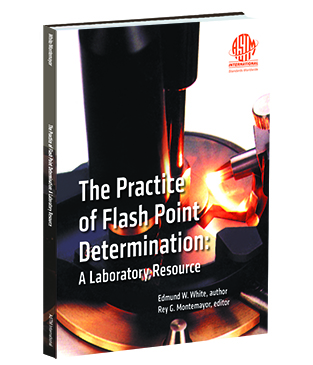
Flash Point Determination
A New ASTM Manual Guides Its Practice
Accurate equipment means accurate test results in many areas - including flash point - and a new reference from ASTM International covers preparing, maintaining and checking apparatus for such testing. ASTM Manual 72, The Practice of Flash Point Determination: A Laboratory Resource, addresses equipment, methods and more.
As introduced in Manual 72, "Flash point is the lowest temperature of a liquid at which sufficient vapor is generated to create a flammable mixture with air in the presence of an ignition source." Flash point is used to classify a liquid material as combustible or flammable; in that way it helps define product quality. And Manual 72 provides laboratory technicians as well as supervisors, and manufacturing and marketing personnel, with information about various aspects of flash point determination.
The nine chapters and five appendixes in Manual 72 address the practical significance and use of flash point, the terminologies used in flash point determination, sample handling and specimen preparation, test apparatus and the various test methods of determining flash point. Editor Rey Montemayor, Ph.D., an ASTM International fellow and long-time member of Committee D02 on Petroleum Products and Lubricants, says that Manual 72 details flash point testing from the time a sample arrives in a laboratory to reporting the test result values. He adds that Manual 72 offers more than other books on the topic: "The information on how sample viscosity affects the flash point, as well as flash point masking, are topics which have been discussed sparingly in other works in this area."
In addition to the attention paid to the proper preparation and use of the apparatus, Manual 72 addresses the precision of various flash point test methods as well as how precision information is obtained. The work also contains information comparing features of different flash point methods, which furthers the understanding of flash point testing.
Specifically, the manual chapters cover:
- Significance and current use of the flash point test methods;
- Explanation and definition of terms;
- Flash point apparatus and auxiliary equipment;
- Sampling and test specimens for flash point determination;
- Preparation, verification and maintenance of apparatus;
- Procedures, corrections and reporting;
- Precision of flash point test methods; and
- Flash point relationships with other volatility properties.
Laboratory operators and technicians who perform flash point tests on various liquid materials will find the manual a useful reference in their work; supervisors and managers should find the flash point test precision details helpful in interpreting results for use by others in the manufacturing and marketing of petroleum products, lubricants, solvents and other volatile liquids or mixtures.
Montemayor notes that the appendixes included in the manual are particularly informative, extending the information about flash point testing as it relates to manufacturing products that could be flammable or combustible. The manual provides a resource to laboratories in satisfying performance specifications for liquid fuels and materials as well as conforming to government safety standards for storage, use and transportation of potentially flammable or combustible materials.
 SN Home
SN Home Archive
Archive Advertisers
Advertisers Masthead
Masthead RateCard
RateCard Subscribe
Subscribe Email Editor
Email Editor